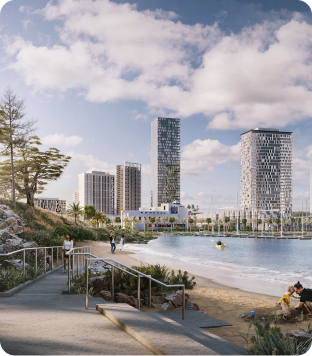
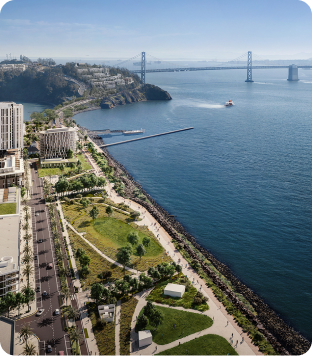
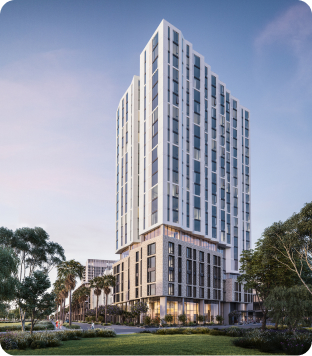
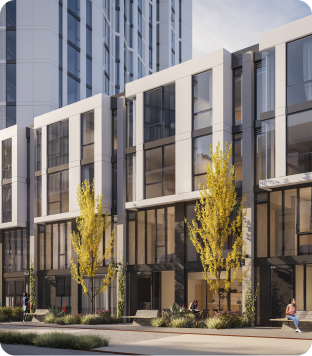
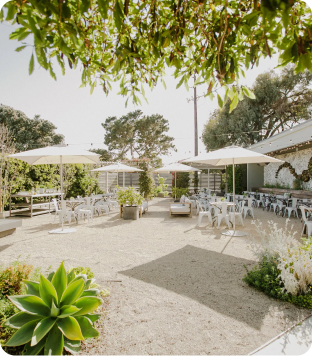

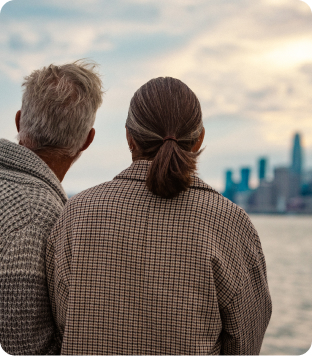
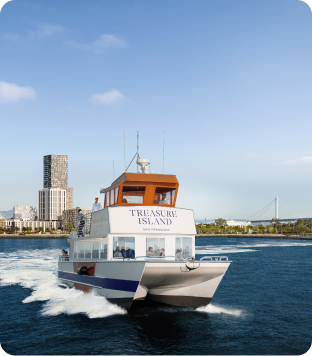

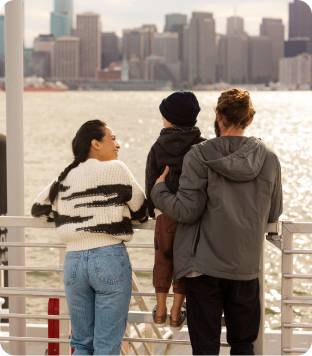
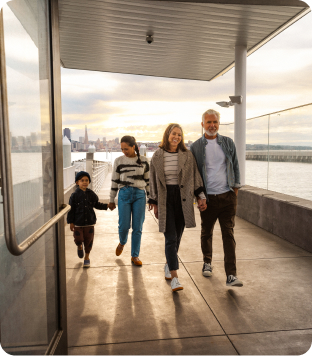
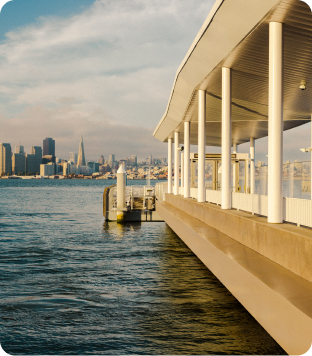
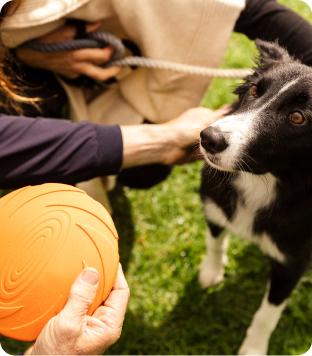
-
General FAQ
-
What new features and public amenities are planned for Treasure Island?
Under the current development plan for Treasure Island and Yerba Buena Island, Treasure Island Community Development (TICD) expects to contribute community benefits and amenities over a period of several years. If Treasure Island is developed as currently planned, and subject to approval and acceptance by applicable governmental agencies, community benefits and amenities may include but are not limited to:
- An extensive collection of new public parks and open space
- One of the highest-scoring LEED-ND projects worldwide, Treasure Island is planned to be a better, more sustainable, well-connected community
- Miles of proposed public hiking and bicycle paths
Beyond the new residential development on Treasure Island, the following are proposed, subject to approval and acceptance by applicable governmental agencies:
- A public safety center to include new Treasure Island Fire and Police Stations
- A new public school site, subject to acceptance by the school district
- New public art A new marina Protected swim lanes at Clipper Cove
- Beach An urban farm Reconstructed athletic fields
-
What infrastructure improvements are proposed for Treasure Island?
Under the current development plan, the following are proposed to be constructed, subject to final acceptance and approval by local governmental agencies:
- All-new utility infrastructure, including public power provided by the San Francisco Public Utilities Commission
- New roads and bicycle network with protected bike lanes serving Treasure Island
- New waste treatment and water systems
- A new Treasure Island ferry terminal and transit hub
- Geotechnical improvements to increase seismic stability and load-bearing capacity of soil beneath the new streets and development parcels
- State-of-the-art, comprehensive sea level rise protections proposed to be constructed over the coming years
-
What types of homes will be on Treasure Island?
The residences planned for Treasure Island are anticipated to include both rental and homeownership opportunities consisting of apartments and condominiums in mid-rise and high-rise buildings. The first stage of development on Treasure Island anticipates up to 1,000 homes with an estimated 2,250 residents in apartments and condominiums. As currently planned, Treasure Island may be home to as many as 18,000 people. These diverse new offerings are for individuals of all ages, families, people with disabilities and veterans at all income levels. Under current development plans, affordable housing for various household income levels may eventually account for up to 27% of the planned total number of homes.
-
When will the first homes on Treasure Island be available?
The first stage of development on Treasure Island is planned to include condominiums and multifamily residences, both market-rate and affordable. Move-ins are currently anticipated to begin in 2024, subject to local and state approvals.
Learn more about the Residences of Yerba Buena Island, which are currently selling.
-
What can I experience on Treasure Island and when?
Treasure Island is a unique destination with an exciting future including new residential development. Today, enjoy incredible 360-degree views of the Bay and access to maritime activities. Also on the island are award-winning cafes and bars like Aracely Cafe, Mersea, and Woods Island Club, which re-opened in Treasure Island’s historic Administration building. Explore the Treasure Island Museum, monumental public art installations, and on-island programmed events proposed over the coming months and years, making Treasure Island an incomparable place to live and visit.
-
When can I visit Treasure Island's parks and green space?
Current development plans for Treasure Island anticipate what may eventually be the largest expansion of public open space in San Francisco since the creation of Golden Gate Park. Treasure Island Landing and the new Little League Fields on Treasure Island and Clipper Cove Beach, Infinity Point, Signal Point, and The Rocks Dog Park on Yerba Buena Island are currently planned to be open for public enjoyment in 2023-2024.
-
What’s close by?
Treasure Island is a celebrated new development in the San Francisco Bay area with unmatched panoramic views just across the Bay. A scenic 10-minute ferry ride from Gate B of the San Francisco Ferry Building, Treasure Island’s central location offers convenient access to all the offerings of the greater Bay Area.
Throughout the week, you’re only a short drive away from downtown San Francisco, as well as Oakland, the East Bay, and the North Bay. And a quick drive to US 101 S makes for a convenient commute to the Peninsula and the South Bay.
On the weekends, enjoy a scenic trip to acclaimed Napa and Sonoma County wine regions, or travel via San Francisco’s international airports, SFO and OAK, also a short drive away.
-
-
Ferry FAQ
-
When will the Treasure Island - Yerba Buena Island ferry service begin?
Ferry service is now operating daily between the new Treasure Island Ferry Terminal and the San Francisco Ferry Building, Gate B.
Click here to view the schedule and book your tickets.
-
Can I bring my bicycle, e-bike, or scooter on the ferry?
Bicycles are welcome on the ferry at no extra cost. They are accommodated on a first come, first served basis, up to a maximum capacity of six (6) bicycles per trip.
Electric scooters are allowed, but on-board charging of any electronic mobility device is prohibited.
No gasoline powered bicycles, motorcycles or mopeds are allowed on board.
-
Where do I go for ferry service alerts?
To find out about changes or interruptions to the Treasure Island – Yerba Buena Island Ferry schedule, please click here or follow @TISFFerry on Twitter.
-
What can I do if my ferry is canceled or delayed?
Occasionally the Treasure Island – Yerba Buena Island Ferry goes out of service due to unsafe weather conditions on the Bay or time-sensitive maintenance needs.
If a ferry service interruption or cancellation impacts your travel plans, please call or text (415) 562-4250 for help arranging alternative transportation.
You can also take the #25 Muni bus, which runs between Treasure Island and the Transbay Transit Center.
-
Does the ferry accept Clipper Card?
The Treasure Island – Yerba Buena Island Ferry does not accept Clipper Card. As a privately-run transportation service, the ferry is not currently eligible to join the Clipper card network.
Tickets may instead be purchased using cash or credit card during boarding or in advance at TISF.com/schedule.
-
Can I take my service animal on the ferry?
Pets are allowed on the ferry in handheld kennels or other airline-approved carriers only.
Service animals outside of carriers must be on a leash or harness and remain in the control of their owners at all times.
-